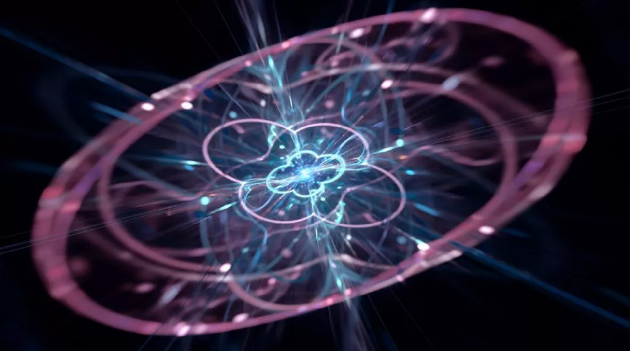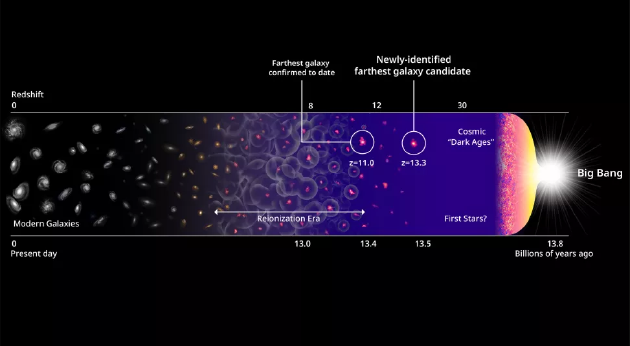Sina Technology News Beijing April 18 news, according to foreign media reports, a large number of gravitons may have formed in the trillionth of a second after the Big Bang, and their numbers may be large enough to explain the existence of dark matter.
A very elusive and exotic matter, dark matter occupies most of the mass of the universe, and it may be composed of gravitons that first appeared after the Big Bang. Gravitons are fundamental particles proposed based on the framework of quantum field theory whose quantum exchange can generate gravity. A new theory suggests that these hypothetical particles may be cosmic relics from extra dimensions.
The researchers’ calculations suggest that there may be just enough of these particles to explain dark matter. At present, physicists have not really observed the existence of dark matter, and can only “observe” it through its gravitational effect on ordinary matter. A large number of gravitons were generated by the collision of ordinary particles in the early universe. In the past, this process was thought to be very difficult to occur, so a large number of gravitons could not be candidates for dark matter.
In a new study, published in the journal Physical Review Letters in February, physicists found that the early universe may have produced large numbers of gravitons, enough to explain the dark matter we currently detect in the universe.

▲ Does the universe have more dimensions than we think?
The study found that if gravitons in the early universe did exist, their masses would be less than 1MeV, no more than twice the mass of an electron. This mass level is well below the scale at which the Higgs boson produces the mass of ordinary matter — the key to the model producing enough Higgs bosons to explain all the dark matter in the universe. (By comparison, the lightest known particle, a neutrino, has a mass of less than 2 eV, while a proton has a mass of about 940 MeV, according to the National Institute of Standards and Technology.)
The research team discovered these hypothetical gravitons while searching for evidence of extra dimensions. Some physicists suspect that there are additional dimensions beyond the three-dimensional space and fourth-dimensional time we have observed. According to the team’s theory, as gravity travels through extra dimensions, it pops up in our universe in the form of massive gravitons.
However, these particles can only weakly interact with ordinary matter, and only through gravity. This description is strikingly similar to what is currently known about dark matter properties: dark matter doesn’t interact with light, but has gravitational effects that can be felt anywhere in the universe. For example, physicists believe that the gravitational effects of dark matter are what prevent galaxies from separating.
In general relativity, gravity is seen as a geometric phenomenon, the curvature of space-time. In current physics, this idea has achieved great success. On the other hand, the view of quantum mechanics holds that the force is produced by the exchange of discrete packets of energy (ie quanta). Different quanta produce different forces. Based on this view, the Standard Model of Quantum Physics believes that fundamental interactions are produced by quantum exchange, and proposes the theory of gauge bosons, such as the electromagnetic force is produced by photon exchange, and the weak nuclear force is produced by W and Z bosons. The exchange of dons is produced, and the strong nuclear force is produced by the exchange of gluons. The theory predicts that gravity should also be created by the exchange of some kind of boson, known as a graviton.

▲ This schematic diagram of the evolution of the universe shows that the earliest stars and galaxies formed in the first few hundred million years after the Big Bang.
The main advantage of the hypothesis of large numbers of gravitons as dark matter particles is that these particles interact only through gravity and thus evade attempts to detect their existence, in contrast to other dark matter candidates – such as the massive weakly interacting particles (WIMP), axions, and neutrinos—may also be detected through their very subtle interactions with other forces and fields. Many scientists believe that WIMP is the most promising candidate for dark matter, but the latest study says dark matter should be less massive than WIMP. There are many experiments currently looking for theoretical WIMP particles that must be performed underground to avoid interference from cosmic rays.
The fact that large numbers of gravitons barely interact with other particles and forces in the universe through gravity provides another advantage. Because their interactions are so weak, they decay so slowly that they remain stable throughout the lifespan of the universe, for the same reason that they were produced slowly during the expansion of the universe, accumulating continuously until today.
Physicists previously thought that gravitons were unlikely candidates for dark matter because their production is extremely rare. So gravitons are produced at a much lower rate than other particles. But the team found that in the trillionth of a second after the Big Bang, there may be far more gravitons than previous theories had thought. The study found that this increase is enough for gravitons to fully explain the amount of dark matter we detect in the universe.
Since a large number of gravitons form below the energy scale of the Higgs boson, they are not subject to the uncertainties associated with higher energy scales, which current particle physics cannot describe well sex. The team’s theory links the physics studied at particle accelerators such as the Large Hadron Collider (LHC) with the physics of gravity. This means that very large particle accelerators like CERN’s Future Circular Collider (FCC) could be used to search for evidence of the existence of these potential dark matter particles. The size of the FCC will be four times that of the LHC, the world’s most powerful particle accelerator, and the impact energy can reach six times that of the LHC. The accelerator is scheduled to start operating in 2035.
.
[related_posts_by_tax taxonomies=”post_tag”]
The post Mysterious dark matter may be a cosmic relic from an extra dimension appeared first on Gamingsym.
